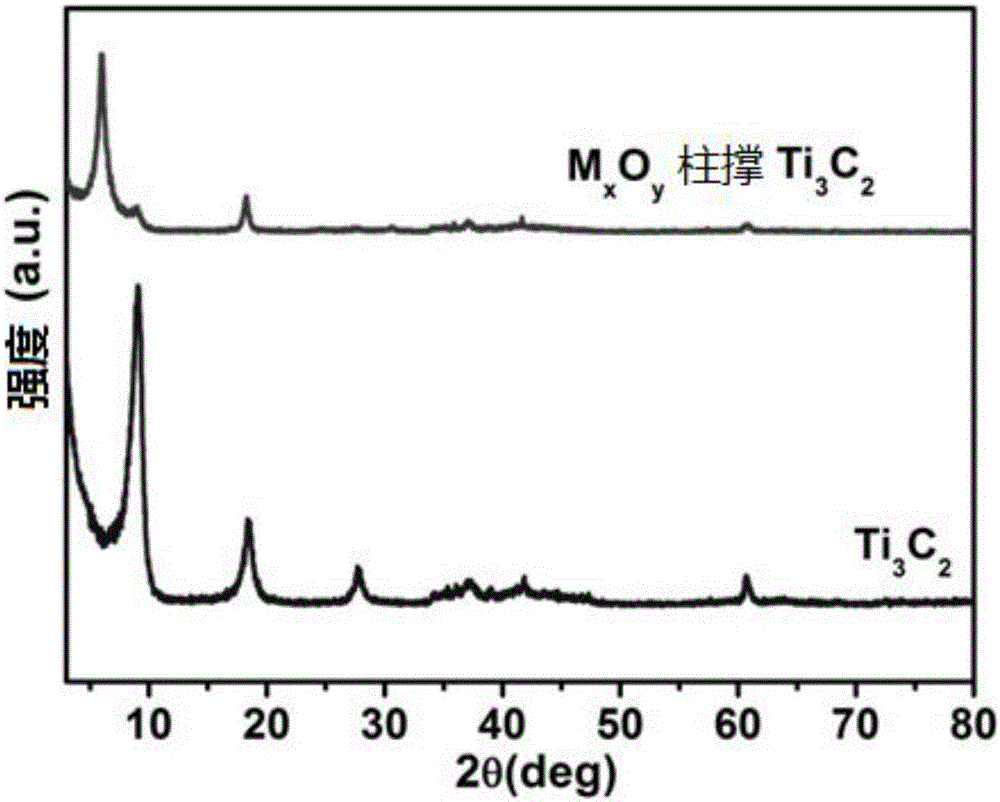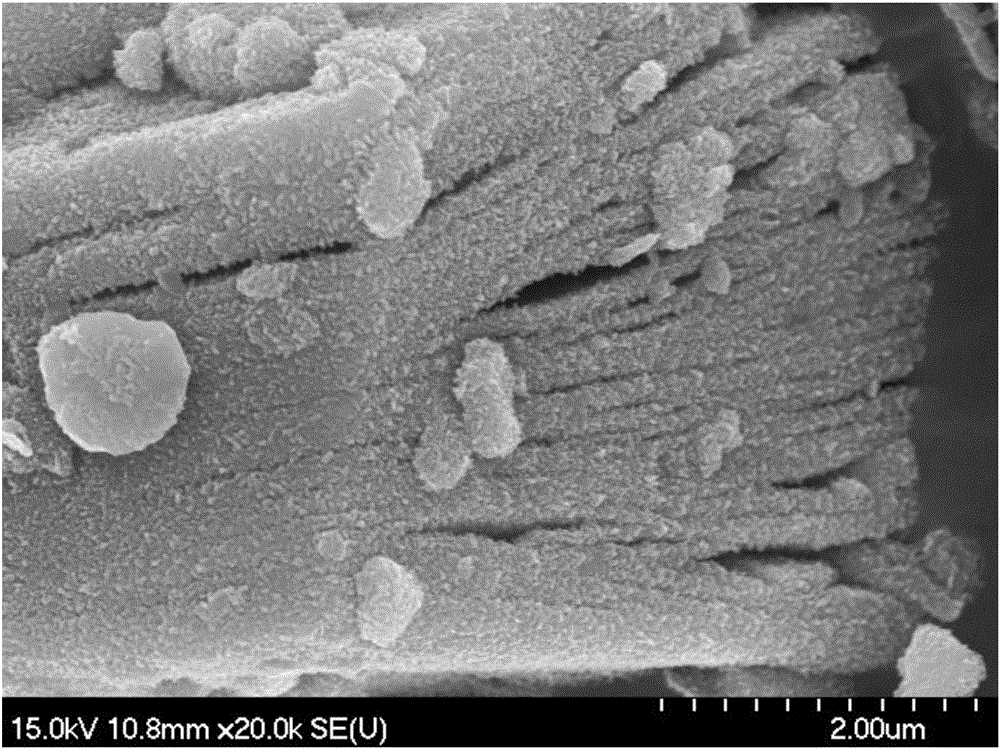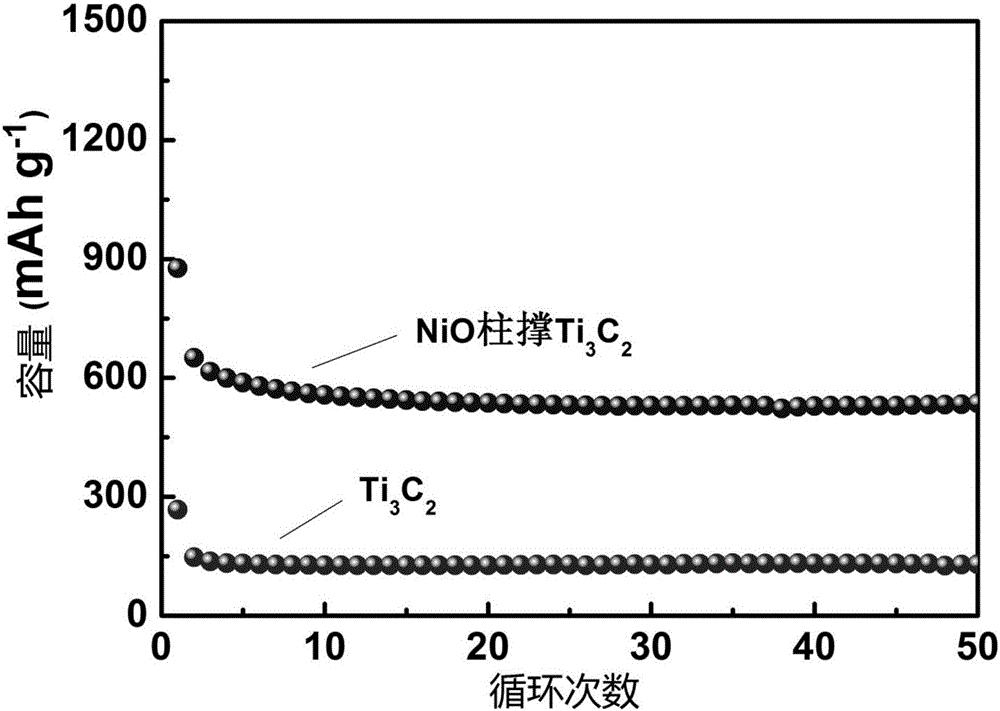Oxide-pillared MXene composite material and application thereof
A technology of composite materials and oxides, applied in the direction of electrochemical generators, electrical components, battery electrodes, etc., can solve the problems of low application capacity and limit the application prospects of MXene, and achieve multi-capacity, stable cycle performance, and simple preparation methods Effect
- Summary
- Abstract
- Description
- Claims
- Application Information
AI Technical Summary
Problems solved by technology
Method used
Image
Examples
Embodiment 1
[0023] Take 2g Ti 3 AlC 2 Put the powder (MAX) into a beaker, add 80ml of 10% HF acid solution, stir, and etch at room temperature for 15h. Then the etched Ti 3 C 2 The MXene powder was centrifuged, washed with deionization to pH = 6-7, and baked in a blast oven at 80°C for 12 hours. 0.1g dried Ti 3 C 2 MXene powder was stirred in 40 mL of a solution containing 0.005 mol / L cetyltrimethylammonium bromide (CTAB) at 30 °C for 5 h, centrifuged, washed with deionization, and dried. Then 0.1g CTAB pre-pillared Ti 3 C 2 The MXene powder was stirred in 40 mL of an aqueous solution containing 0.3 mol / L nickel nitrate at 40 °C for 6 h, washed with deionized water, and dried. Afterwards, the NiO pillared Ti 3 C 2 MXene material.
[0024] Using the NiO pillars made in Example 1 to support Ti 3 C 2 MXene material powders were prepared into electrodes as follows.
[0025] Weigh NiO pillared Ti with a mass ratio of 80:10:10 3 C 2 MXene material: super-P: PVDF, ground evenly t...
Embodiment 2
[0027] Take 1.5g Ti 2 Put AlC powder into a beaker, add 40ml of HF solution with a mass fraction of 50%, stir, and etch at room temperature for 6h. Then the etching powder is centrifuged out of Ti 2 C MXene powder, washed with deionization to PH = 6-7, baked in a blast oven at 80°C for 18h. Dry 1g of Ti 2 C MXene powder was stirred in 60 mL of a solution containing 0.03 mol / L dodecyltrimethylammonium bromide (DTAB) at 50 °C for 3 h, centrifuged, washed with deionization, and dried. 1 g DTAB pre-pillared Ti 2 C MXene powder was stirred in 60 mL ethanol solution containing 0.06 mol / L ethyl orthosilicate at 25 °C for 12 h, washed with deionized water, and dried. Afterwards, in an argon atmosphere at a heating rate of 5°C / min at 500°C for 2h to obtain SiO 2 Pillar Ti 2 C MXene materials. With the prepared SiO 2 Pillar Ti 2 The C MXene material is made into an electrode according to the method of Example 1, assembled into a molded lithium ion battery, and the discharge cap...
Embodiment 3
[0029] Take 2.5g Nb 2 Put AlC powder into a beaker, add 10ml of HF solution with a mass fraction of 25%, stir, and etch at room temperature for 8h. Then the etch powder is centrifuged out of Nb 2 C MXene powder, washed with deionization to PH = 6-7, baked in a blast oven at 80°C for 6h. 1.5g of dried Nb 2 C MXene powder was stirred in 50 mL of a solution containing 0.05 mol / L octadecyltrimethylammonium bromide (STAB) at 60 °C for 10 h, centrifuged, washed with deionization, and dried. Then 1.5g STAB pre-pillared Nb 2 The CMXene powder was stirred in 50 mL methanol solution containing 0.06 mol / L tetrabutyl titanate at 45 °C for 15 h, washed with deionized water, and dried. Afterwards, in an argon atmosphere at a heating rate of 3 °C / min at 600 °C for 3 h to obtain TiO 2 Pillar Nb 2 C MXene materials. With the prepared TiO 2 Pillar Nb 2 The C MXene material is made into an electrode according to the method of Example 1, and assembled into a molded lithium-ion battery. T...
PUM
 Login to View More
Login to View More Abstract
Description
Claims
Application Information
 Login to View More
Login to View More - R&D
- Intellectual Property
- Life Sciences
- Materials
- Tech Scout
- Unparalleled Data Quality
- Higher Quality Content
- 60% Fewer Hallucinations
Browse by: Latest US Patents, China's latest patents, Technical Efficacy Thesaurus, Application Domain, Technology Topic, Popular Technical Reports.
© 2025 PatSnap. All rights reserved.Legal|Privacy policy|Modern Slavery Act Transparency Statement|Sitemap|About US| Contact US: help@patsnap.com



